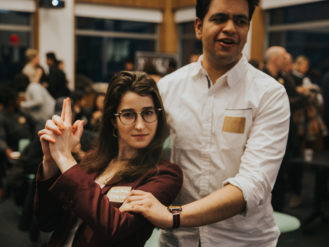A Social Network Where Artists Get Fair Play (and Pay)
At the Ethereal Summit, a platform called DADA wins funding from Brooklyn's ConsenSys. Plus other observations from the expo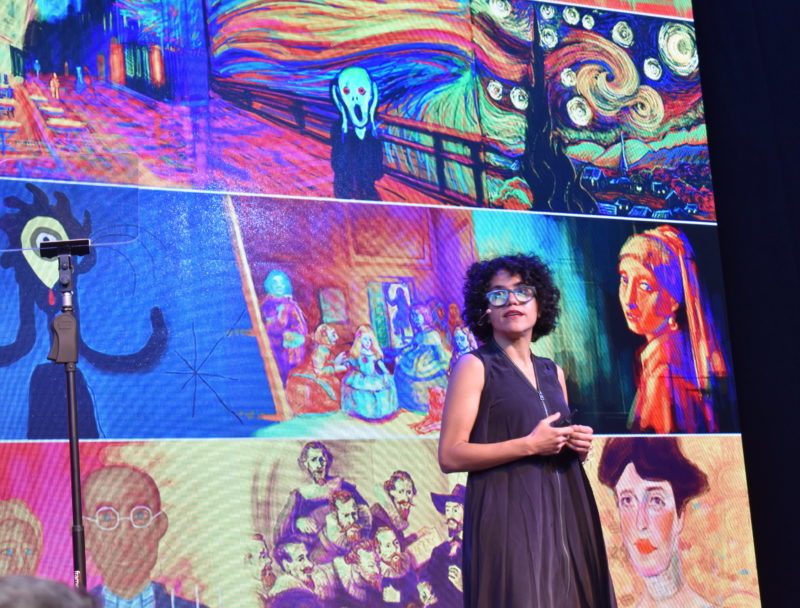
Said Ramos at the summit: "I believed there was a way to be a real artist without going broke” (Photo by Steve Koepp)
Beatriz Ramos had been commercially successful as an artist and director, producing work for the likes of MTV and Disney, as well as commercials for Coca-Cola and Kraft. But the Venezuelan native had an awakening a few years ago: “I was not a starving artist, but I starved my art.”
Not only that, “I didn’t own any of the intellectual rights to any of the work I’ve done over the last 20 years,” she said in a talk on Friday at the Ethereal Summit, a two-day conference on blockchain technology. She was determined to find a solution to the artist’s dilemma: it’s hard to pursue freedom of expression and still get paid. “I believed there was a way to be a real artist without going broke,” she said.
Her answer was to launch DADA, a social network for visual art that uses Ethereum blockchain technology to track the provenance of the work and give artists a stake in future sales. The DADA platform now contains more than 100,000 drawings, to which artists can reply with their own work, creating a visual conversation. “What’s beautiful is that all of these have been created all over the world by people who have never met each other,” said Ramos.
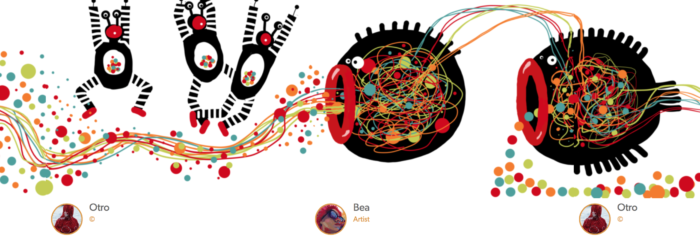
A sample from a long horizontal scroll of collaborative artwork on DADA (Image courtesy of DADA)
The contributing artists maintain control of their work, she said. “Smart contracts track and verify every transaction,” she said, so that if a business wants to license an image for, say, a T-shirt, the artist will earn fees. Even for transactions in the secondary market, where work may be resold, the artist gets 30% of the profit. Ramos has said that DADA will never accept advertising or charge subscriptions; revenue will come from artwork sales.
All of the work on the site is original and created on the platform, which reduces the risk of users introducing previously copyrighted material. It also has a unique user experience, given its visual nature. “One of the most controversial things was that our scroll is horizontal, not vertical,” Ramos told The Rumpus, an online literary magazine.

Art for sale in limited editions on the DADA platform (Images courtesy of DADA)
“The internet developed with hyperlinks and it was all text, and it made sense that everything was scrolling down,” she explained. “But theater and television screens are never going to change, no matter how many people shoot things with cell phones vertically. The truly visual is always going to be horizontal.”
The day after Ramos’s vividly illustrated presentation at the Knockdown Center event space in Maspeth, Queens, her company announced that ConsenSys Ventures will be making an investment in the company as part of its portfolio of startups. The VC firm, which launched last year with a $50 million fund, is the investment arm of Brooklyn-based ConsenSys, the host of the summit and the hub of the Ethereum ecosystem. “This is wonderful news,” declared DADA, which earlier had pitched to investors in Silicon Valley. “We couldn’t have better strategic partners and a nicer team of collaborators.”
Ramos believes that DADA, like its namesake art movement, is revolutionary. It will bring would-be artists into the marketplace, she said, as well as giving career artists “the freedom to do the work they love.”
DADA founder Beatriz Ramos talked with The Bridge editor Steve Koepp at the Ethereal Summit (Video by Arden Phillips)
A Tool for Social Justice?
While much of the attention paid to the Ethereum universe focuses on the price of its cryptocurrency, ether (ETH), not all blockchain enthusiasts are obsessed with trading for profit. In fact, the Ethereum Foundation was created with the idea that blockchain technology “has the potential to make the world a better place by recovering the balance society has lost,” said Aya Miyaguchi in a talk at the summit.
Miyaguchi, who joined the foundation as executive director in February, said the foundation has given $5.4 million in grants this year to 35 individuals and groups. Among the issues the foundation hopes to address through blockchain applications are hunger, energy waste, gender inequality, human trafficking, and unfair trade, she said.
Much of the impetus for the foundation’s goals comes from Ethereum co-founder Vitalik Buterin. “He tweets a lot,” said Miyaguchi, calling up a slide showing Buterin’s calls for a higher purpose. Miyaguchi said the movement for social justice should rally around the term BUIDL, a twist on “build,” which is meant to contrast with HODL, a slang term in the Bitcoin community for holding the cryptocurrency rather than selling it. “We focus on the work,” said Miyaguchi. “I stopped checking the price.”
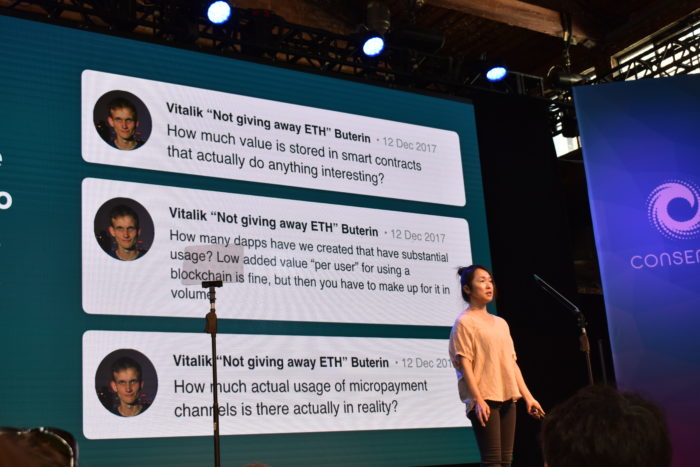
Miyaguchi making her presentation, including a series of tweets by Ethereum’s co-founder, Vitalik Buterin (Photo by Steve Koepp)
A Few Words from the Founder
The mild-mannered rock star of the Ethereal Summit is Joseph Lubin, the Canadian-born computer scientist who founded ConsenSys. At last week’s event, he rotated between onstage roles and mingling with the crowd, clad in a T-shirt and jeans and carrying a large backpack. At brief news conferences, he took questions from the press, including journalists now dedicated to the blockchain beat.
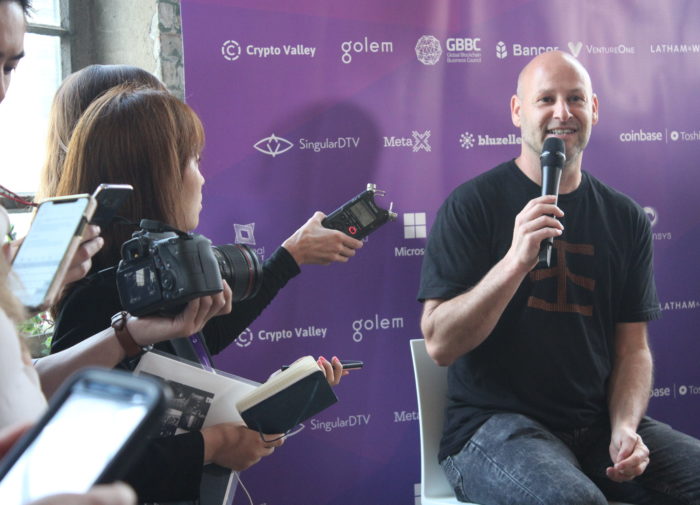
ConsenSys founder Lubin taking questions from reporters (Photo by Arden Phillips)
Asked if the mania over blockchain’s decentralization of power is partly the result of the monopoly position of giants like Facebook and Google, he said it didn’t start out that way. “Early on, it wasn’t really a backlash to Silicon Valley. It was a growing distrust in centralized institutions like banks,” he said.
But the scandal over Facebook users’ data being harvested without their knowledge has aggravated the backlash, he suggested. “Cambridge Analytica is kind of helping our case right now,” he said. “The business model of exploiting people and their information is going to change.” He said he envisions “a world where Silicon Valley companies can still get information if we make it available. They may have to pay for the data, but it will be better data.”
The Ethereal Summit’s Circus of Apps
At the summit, an array of exhibitors spread out through the corridors and courtyards of the venue, showing the crowd all the ways in which Ethereum is being put to use. A social-justice app on display was Bail Bloc, described as “a cryptocurrency sheme to get people out of jail,” responding to the inequity of the bail system.
Another application, exhibited in a suitably mysterious bunker-like building, was Cellarius, a collaborative sci-fi platform set in the near future. “The framework of the universe is ostensible,” explained Sean O’Connor, whose business card describes his role as “minister of truth.”

A painter in the Cellarius exhibit depicting how the venue site might look in 100 years (Photo by Steve Koepp)
The universe will be populated by its community of writers, illustrators and other artists who contribute their work. The platform will use Ethereum technology to track the source of the contributions and potentially paying the artists as well.
While the narrative will be curated by the contributors, Cellarius already has a narrative framework that includes events like the collapse of the world’s fiat currencies in 2036 and artificial intelligence “hardening control over earth,” said O’Connor. One of the goals of Cellarius, he said, was to make technological trends “more accessible to people not on the cutting edge of tech but who will be impacted by it.”
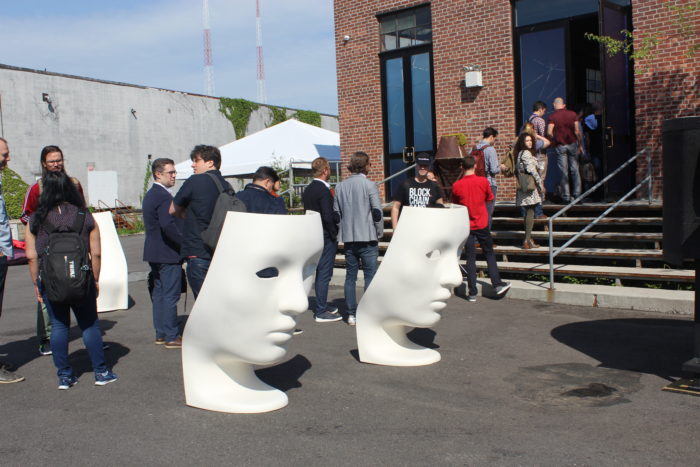
A crowd expected to total 2,000 lined up at the start of the summit in Maspeth, Queens (Photo by Arden Phillips)

In the Zen Zone, participants laid down to meditate over suitably calming music (Photo by Steve Koepp)
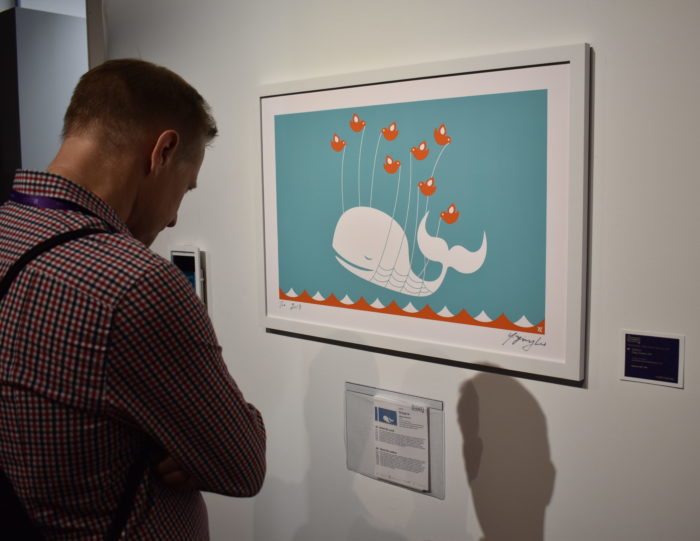
Limited-edition artwork focusing on tech themes was auctioned at the event, with the proceeds used to support artists whose work engages with the blockchain and crypto collectibles (Photo by Steve Koepp)
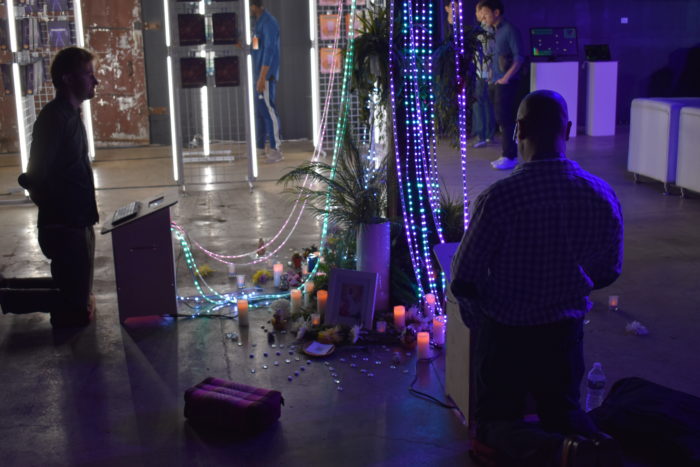
One of the more whimsical (perhaps spiritual) exhibits was a shrine connected to keyboards where people could enter their prayers. As he prepared to type, one participant asked a bystander, “Do you think it’s OK to pray for the Ticketmaster monopoly to fail?” (Photo by Steve Koepp)





